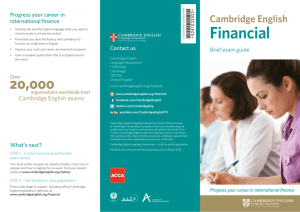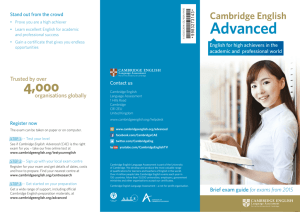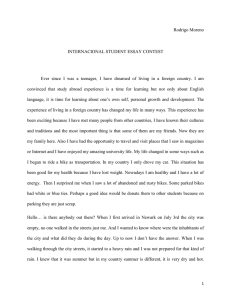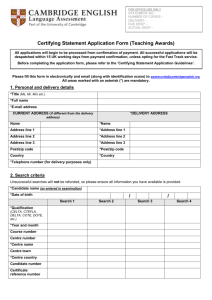Proficiency Speaking Sample test with examiner`s comments
advertisement
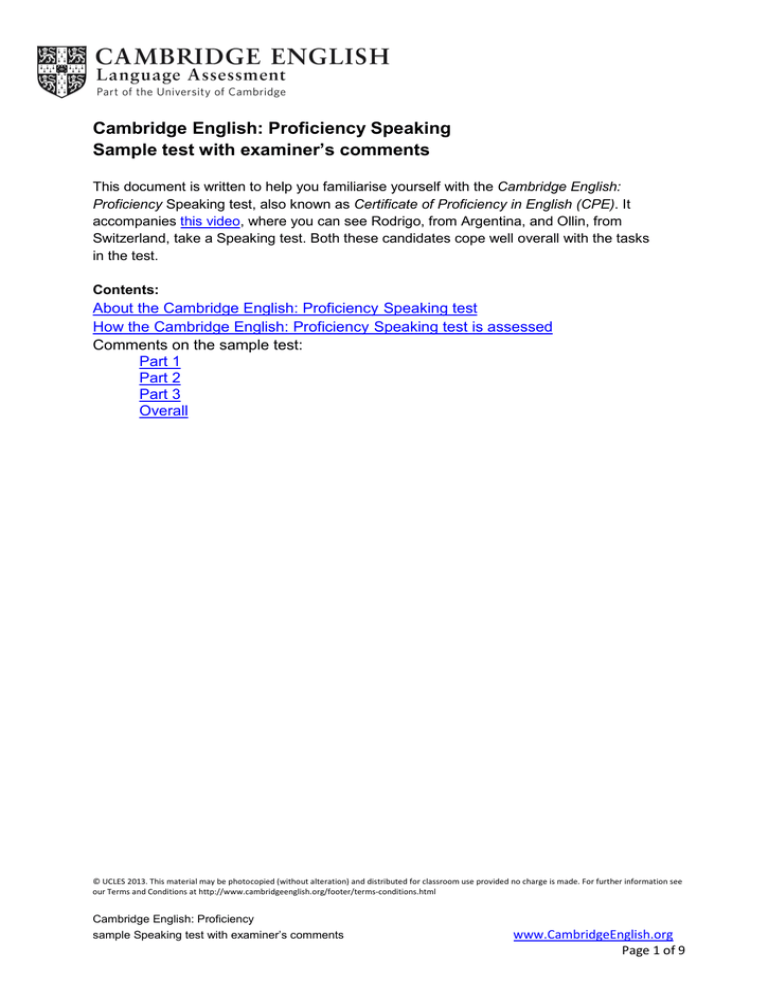
Cambridge English: Proficiency Speaking Sample test with examiner’s comments This document is written to help you familiarise yourself with the Cambridge English: Proficiency Speaking test, also known as Certificate of Proficiency in English (CPE). It accompanies this video, where you can see Rodrigo, from Argentina, and Ollin, from Switzerland, take a Speaking test. Both these candidates cope well overall with the tasks in the test. Contents: About the Cambridge English: Proficiency Speaking test How the Cambridge English: Proficiency Speaking test is assessed Comments on the sample test: Part 1 Part 2 Part 3 Overall © UCLES 2013. This material may be photocopied (without alteration) and distributed for classroom use provided no charge is made. For further information see our Terms and Conditions at http://www.cambridgeenglish.org/footer/terms-conditions.html Cambridge English: Proficiency sample Speaking test with examiner’s comments www.CambridgeEnglish.org Page 1 of 9 About the Cambridge English: Proficiency Speaking test The Speaking test is 16 minutes long and consists of three parts. The standard test format is two candidates and two examiners. One examiner (the interlocutor) conducts the test, providing you with the necessary materials and explaining what you have to do. The other examiner (the assessor) will be introduced to you, but then takes no further part in the interaction. Part 1 (2 minutes) The interlocutor first asks you and your partner a few questions which focus on information about yourselves. Part 2 (4 minutes) In this part of the test you and your partner are asked to talk together. The interlocutor places a set of pictures on the table in front of you. There may be only one picture in the set or as many as seven pictures. This stimulus provides the basis for a discussion. The interlocutor first asks an introductory question which focuses on two of the pictures (or in the case of a single picture, on aspects of the picture). After about 1 minute, the interlocutor gives you both a decision-making task based on the same set of pictures. Part 3 (10 minutes) You are each given the opportunity to talk for 2 minutes, to comment after your partner has spoken and to take part in a more general discussion. The interlocutor gives you a card with a question written on it and asks you to talk about it for 2 minutes. After you have spoken, the interlocutor asks you both another question related to the topic on the card, addressing your partner first. This procedure is repeated, so that your partner receives a card and speaks for 2 minutes and a follow-up question is asked. Finally, the interlocutor asks some further questions, which leads to a discussion on a general theme related to the subjects already covered in Part 3. © UCLES 2013. This material may be photocopied (without alteration) and distributed for classroom use provided no charge is made. For further information see our Terms and Conditions at http://www.cambridgeenglish.org/footer/terms-conditions.html Cambridge English: Proficiency sample Speaking test with examiner’s comments www.CambridgeEnglish.org Page 2 of 9 How the Cambridge English: Proficiency Speaking test is assessed What the examiners are interested in As you do the test, the assessor focuses on these areas of your English: Grammar – Are you using a wide range of grammatical structures? Are you using these structures correctly? Are you showing that you can be flexible in your use of grammar? Vocabulary – Are you using a wide range of vocabulary? Is the vocabulary appropriate for the subject you’re talking about? Are you using this vocabulary correctly? Are you showing that you can use suitable vocabulary to discuss topics that are abstract and unfamiliar to you, as well as topics you are used to talking about? Discourse Management – Are you showing that you can give both long and shorter answers? Are you able to speak fluently? Is what you’re saying relevant to the subject of the discussion? Are you able to discuss a subject in detail and at a more general level too? Is what you’re saying clear and well organised? Are you using a wide range of words and phrases to connect your ideas and organise what you are saying? Pronunciation – You don’t need to have a perfect English accent, but you need to be clear at all times. Are you pronouncing individual words clearly? Is your voice going up and down at the right times? Are you stressing the right parts of words, and the right words in sentences? Does your pronunciation help you to communicate what you mean in a clear and effective way? Interactive Communication – Are you able to interact with the other candidate easily and effectively? Are you listening to the other candidate and answering in a way that makes sense? Are you able to start and develop a discussion? Are you able to manage the discussion so that you and the other candidate come to an agreement about a decision? The interlocutor focuses on your Global Achievement. This is about your general performance. How well are you speaking about the topics you’re given? Are your answers clear and fluent? Are you using language that is right for the Cambridge English: Proficiency level? When your test is complete, the examiners give you marks for each of these things – Grammar, Vocabulary, Discourse Management, Pronunciation, Interactive Communication and Global Achievement. The marks are for what you do over the whole Speaking test, not for each part of the test. The examiners give you marks for your own performance – they don’t compare you with the other candidate. © UCLES 2013. This material may be photocopied (without alteration) and distributed for classroom use provided no charge is made. For further information see our Terms and Conditions at http://www.cambridgeenglish.org/footer/terms-conditions.html Cambridge English: Proficiency sample Speaking test with examiner’s comments www.CambridgeEnglish.org Page 3 of 9 Comments on the sample test Part 1 Rodrigo Ollin Rodrigo gives clear and appropriate short Ollin also gives clear and appropriate answers to the first two questions. short answers to the first two questions. For the third question – How good are you at organising your time? – Rodrigo also gives a clear and relevant answer. The first thing he says – that’s a good question – gives him a few seconds to think about what he is going to say. It’s fine to use ‘fillers’ like these, as we do it in everyday conversation. For the third question – Do you have much opportunity to travel? – Ollin’s answer is clear and relevant. She begins in a very natural conversational way by laughing and saying Yes, luckily I have. The rest of her answer is accurate and appropriate. As with Rodrigo, she could perhaps have Rodrigo then shows a good range of said a little more in answer to this third vocabulary: I keep putting things off to question. Some details about places she the end and procrastinating and that has been to would have shown she is kind of stuff. I try to set deadlines but … able to talk about something in detail, as well as at a general level. Rodrigo could perhaps have said a little more in answer to the third question. An example of when he has ‘put something off’, for instance, would have shown his ability to talk about something in detail. However, his answers were generally of a reasonable length for Part 1. Part 1 tips • practise giving information about yourself • give a few details as well as general information • give short answers, but be prepared to extend them • don’t memorise answers about yourself – this will sound unnatural. Part 2 Rodrigo Ollin In the first task of Part 2 (how common In the first task of Part 2 (how common these situations are in your country), these situations are in your country), Rodrigo performs well in terms of Ollin responds easily and appropriately Interactive Communication. For example, too. Although she says less than he asks Ollin questions, and links his Rodrigo, she does well in terms of contributions to what ollin has said. The Interactive Communication. range of Grammar and Vocabulary that Rodrigo uses is not particularly wide, but sufficient for the task. © UCLES 2013. This material may be photocopied (without alteration) and distributed for classroom use provided no charge is made. For further information see our Terms and Conditions at http://www.cambridgeenglish.org/footer/terms-conditions.html Cambridge English: Proficiency sample Speaking test with examiner’s comments www.CambridgeEnglish.org Page 4 of 9 In the second task of Part 2 (issues relating to working in the food industry for a documentary), Rodrigo again starts the discussion in an effective way. He also links his comments with what Ollin says in an effective way: e.g. I agree because picture B’s more fast food, something quickly in the move, whereas picture A is more like enjoying a meal, a social event. So, yeah, I think you’re absolutely right about it. In the second task of Part 2 (issues relating to working in the food industry for a documentary), Ollin responds to Rodrigo’s first question like this: it represents, I think, the whole fast food economy, which might not be representative for the whole food industry, but it’s still a very important aspect of it… Despite the minor grammatical error (representative for), this comment contains a level of vocabulary and grammar) which Cambridge English: Proficiency candidates are expected to be able to use. It also shows that Ollin is able to deal with abstract ideas in a clear and fluent way. In her next comment, Ollin shows good use of sentence stress to get her meaning across: … comparing that picture, for example, to picture A. General comments on Part 2 Rodrigo uses a fairly good range of Grammar and Vocabulary in this part. He makes very few errors, but he could probably be a little more ambitious in the words and structures he uses. In terms of Discourse Management, Rodrigo’s contributions are relevant and coherent, and he makes effective use of linking and organising words and phrases (e.g. whereas, but what caught my attention was). Rodrigo’s Pronunciation is always intelligible, and gets his meaning across effectively. In this part, Rodrigo shows his ability to interact effectively and negotiate an agreement, so he would score well on General comments on Part 2 Ollin makes a few small grammatical errors in this part, but she uses a good range of Grammar quite effectively. She also uses a good range of appropriately abstract Vocabulary for this kind of Cambridge English: Proficiency task. Although Ollin usually leaves it to Rodrigo to start the discussion and to bring it to a conclusion, she listens carefully to what he says and responds appropriately. So, although Ollin’s role in the interaction is a little different from Rodrigo’s, she takes part effectively, and so does well in terms of Interactive Communication. © UCLES 2013. This material may be photocopied (without alteration) and distributed for classroom use provided no charge is made. For further information see our Terms and Conditions at http://www.cambridgeenglish.org/footer/terms-conditions.html Cambridge English: Proficiency sample Speaking test with examiner’s comments www.CambridgeEnglish.org Page 5 of 9 Interactive Communication. Part 2 tips • remember that the first task in Part 2 helps you to become familiar with the pictures • remember that the second task in Part 2 has a different focus from the first task – it’s usually more abstract • if you can’t remember all the instructions, check with the other candidate or the interlocutor • listen carefully and link what you say to what the other candidate says • discuss all the pictures in some detail before you try to reach a decision. Part 3 Rodrigo Ollin Question following Ollin’s 2-minute First part – 2-minute talk talk Ollin makes a few small grammatical Rodrigo’s response to this question is errors, but she generally maintains good adequate. By using although, he shows control of her Grammar. She also he can use a fairly complex grammatical attempts a few quite complex sentences: e.g. it’s very important that you decide on structure. He also shows some range in his vocabulary – so I can gauge what I something because you are convinced want to do. by it and not because someone else convinced you for that. The preposition error at the end here is only minor. First part – 2-minute talk Rodrigo uses a fair range of Grammatical structures – e.g. Facebook at the Ollin’s Pronunciation is always beginning used to be just about talking to intelligible, and she makes good use of people … but nowadays the first things sentence stress to get her meaning you see are …; you have left-wing across. There are occasional errors with newspapers as opposed to right-wing. individual sounds and word stress (e.g. persuaded), but these never make her He also shows an adequate range of Vocabulary to be able to discuss the unclear. topic. However, he is sometimes not very accurate in his use of certain words and Ollin does quite well in Discourse phrases – e.g. a consumption society Management. She speaks for the full 2 (which should be a consumer society). minutes, and what she says is relevant and generally well organised. By starting with the sentence I think it’s a really In terms of Discourse Management, interesting question … well, of course it’s Rodrigo does quite well. He introduces a very personal question, Ollin gives the topic effectively by stating the question – so the question is about …. herself a little time to think about what Then he makes use of the ideas on the she’s going to say. She uses simple but card to organise his talk and help him effective words and phrases to connect the different points she makes – e.g. you keep going, and he expresses his ideas © UCLES 2013. This material may be photocopied (without alteration) and distributed for classroom use provided no charge is made. For further information see our Terms and Conditions at http://www.cambridgeenglish.org/footer/terms-conditions.html Cambridge English: Proficiency sample Speaking test with examiner’s comments www.CambridgeEnglish.org Page 6 of 9 in a way that is generally clear. Question following Rodrigo’s 2-minute talk Rodrigo links the point he makes to Ollin’s previous comment, but then develops it further. So, he does well in terms of Interactive Communication. However, what he says becomes a little unclear, and, also, he could probably have said a little more. always have to be able to … defend your own opinions and you can only do so if you actually decided to do it by yourself…. Question following Ollin’s 2-minute talk Ollin seems surprised to be asked this follow-up question and spends about 10 seconds hesitating over what to say. What she says eventually is fine, but without the hesitation she could have displayed more of her ability in English. Question following Rodrigo’s 2-minute talk Ollin is ready to answer this question and makes her point in a clear and precise way. She shows her ability to construct more complex sentences and to use more advanced vocabulary – e.g. not just concerning violence but also other aspects .... small children might not be mature enough to think about and to realise what it means. Ollin probably has time to say a little more here. She could perhaps have given an example to illustrate her point. Final discussion Rodrigo again shows he can use a fair range of Grammatical structures with accuracy – e.g. I don’t like being told what I have to do. He also uses a range of Vocabulary – e.g. I find it tricky to decide and to come to terms with. Final discussion Ollin again shows she can use some fairly complex Grammatical forms in a largely accurate way, and she uses some good Cambridge English: Proficiency level Vocabulary – e.g. I actually feel mostly overwhelmed. In terms of Discourse Management, his contributions are clear and appropriate, and he uses a good range of linking words and phrases to help him organise what he says – e.g. the first thing that came into my mind was …; on one hand …but on the other hand …. In terms of Discourse Management, her comments are always relevant and clear, although she could probably have said a little more. She interacts naturally and effectively with the interlocutor and the other © UCLES 2013. This material may be photocopied (without alteration) and distributed for classroom use provided no charge is made. For further information see our Terms and Conditions at http://www.cambridgeenglish.org/footer/terms-conditions.html Cambridge English: Proficiency sample Speaking test with examiner’s comments www.CambridgeEnglish.org Page 7 of 9 . candidate. She clearly links what she says to Rodrigo’s contributions – e.g. and, as you said, Fair Trade. Part 3 tips • in the 2-minute talk, make sure you discuss the question on the card • use the words on the card if you feel they will help you organise your ideas • try to speak for the full time given in each part of the test • give detailed examples, as well as expressing general ideas • practise giving 2-minute talks on a range of topics. Overall Rodrigo Ollin Grammar: Throughout the test Rodrigo Grammar: Ollin uses a good range of uses a fairly good range of grammatical grammatical structures all through the structures. He makes occasional errors test. She makes a few errors but none of but none of these affect the clarity of these affect the clarity of what she says. what he says. To score top marks, he To score top marks, she would probably would probably need to show a wider need to show a wider range of range of grammatical structures. grammatical structures. Vocabulary: Rodrigo uses a fairly wide Vocabulary: Ollin uses a good range of range of appropriate words and phrases. appropriate words and phrases, although Sometimes, the way he uses vocabulary occasionally they are not used entirely isn’t quite correct, but what he means is accurately. Ollin appears to have a good always clear. To receive top marks, he knowledge of vocabulary, but to score would probably have to show a wider top marks, she would probably need to range of vocabulary. demonstrate what she knows more often. Discourse Management: Rodrigo’s Discourse Management: Ollin’s contributions are always relevant and contributions are always relevant and clear. He makes good use of detailed clear. She speaks particularly well at a examples, but also speaks at a more more general level, but would also general level. He uses linking words and benefit from making greater use of phrases effectively to organise his ideas. detailed examples. She organises what To score top marks, he would probably she says effectively and uses linking need to say a little more and with greater words and phrases to do this. To score fluency. top marks, she would probably need to Pronunciation: Although certain say a little more. individual sounds are influenced by his Pronunciation: Although certain first language, Rodrigo is always individual sounds and word stress are intelligible, and he sometimes uses influenced by her first language, Ollin is stress and intonation well to get across always intelligible, and she sometimes the points he makes. uses stress and intonation well to make Interactive Communication: Rodrigo her points. interacts easily with the other candidate Interactive Communication: Ollin © UCLES 2013. This material may be photocopied (without alteration) and distributed for classroom use provided no charge is made. For further information see our Terms and Conditions at http://www.cambridgeenglish.org/footer/terms-conditions.html Cambridge English: Proficiency sample Speaking test with examiner’s comments www.CambridgeEnglish.org Page 8 of 9 and the interlocutor. He takes the initiative, makes effective links with what the other candidate says and develops points in new directions. Global Achievement: Rodrigo generally answers the questions well. He shows he is able to discuss a wide range of topics and to express some fairly complex ideas in a clear way, though he is not always very fluent or accurate in his use of language when dealing with certain unfamiliar topics. interacts easily with the other candidate and the interlocutor. She links what she says to Rodrigo’s contributions in an effective way, and develops points in new directions. To score top marks for this, she may need to take the lead in the discussions a little more. Global Achievement: Ollin generally answers the questions well. She discusses a wide range of topics and expresses some fairly complex ideas clearly, though she is not always very accurate in her use of language when dealing with certain unfamiliar topics. © UCLES 2013. This material may be photocopied (without alteration) and distributed for classroom use provided no charge is made. For further information see our Terms and Conditions at http://www.cambridgeenglish.org/footer/terms-conditions.html Cambridge English: Proficiency sample Speaking test with examiner’s comments www.CambridgeEnglish.org Page 9 of 9



